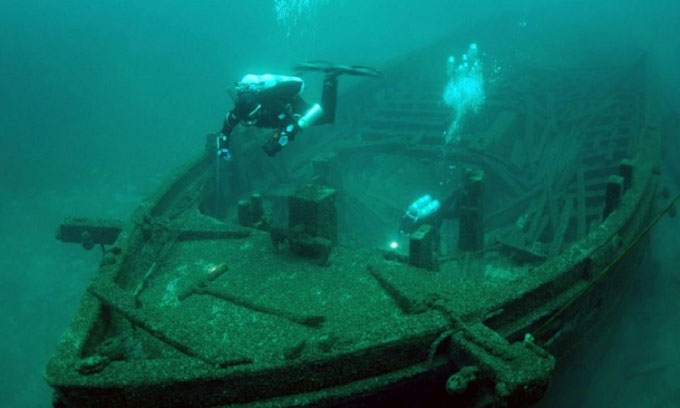The lake can hold up to 2,500 shipwrecks
As one of the most navigable inland waterways in the world, Lake Erie is also known as a shipwreck graveyard in the Five Lakes region.
Although the second smallest of the Five Lakes system, the number of shipwrecks in Lake Erie may be as high as 2,500, according to estimates by some archaeologists and historians. So far, researchers have only found and identified 277 ships. But the list is constantly being added as underwater explorers conduct aerial and underwater searches.

Divers examine the wreck of a ship at the bottom of a lake. (Photo: Garret Ellison).
Lake Erie became an important transportation route in North America in the 18th century. The lake covered the area from western New York to northern Ohio and southern Michigan, providing quick shipping routes for merchants. and explorers. Most likely the majority of ships sank in Lake Erie in the 17th and 18th centuries. But these ships were quite small, making it difficult for divers today to find. As a result, exploration and restoration activities focused on ships that sank at the bottom of Lake Erie in the 19th and 20th centuries.
The most famous shipwreck discovery in Lake Erie happened six years ago. The Five Lakes Museum in Toledo, Ohio, announced the discovery of a lost ship 186 years ago. In September 1829, the 14-meter-long ship named Lake Serpent left Cleveland for Cunningham Island, 88 kilometers away. After being loaded with limestone, the ship sailed back to Cleveland but was suddenly hit by a storm and sank along the way.
Another hotspot for underwater archaeologists exploring Lake Erie is the Manitou Passage, a waterway located near Traverse City, Michigan. In the 19th century, this treacherous route claimed the lives of many sailors on ships carrying timber between ports.
Lake Erie was an important battleground during the war of 1812. Some of the shipwrecks scattered across the lake's bottom were battleships sunk during this period. Urbanization along the lake's shores fueled trade and fishing in the 19th century, leading to a spike in shipwrecks. Many ships were wrecked by big waves during sudden storms in the Five Lakes region.
Archaeologists estimate that about 80% of the shipwrecks in Lake Erie are still in underwater graveyards . Shipwrecks are usually located quite close to the water surface due to the relatively shallow lake. Whether easily spotted from the lake or viewed from above, ships are also more susceptible to erosion from high waves and warm water temperatures.
- Excavation of shipwrecks for 500 years carrying
- Introducing more than 4,000 antiques on wrecked ships
- The mystery of sunken ships in Vietnam: Under the ocean!
- Be ecstatic with the most beautiful lakes in the world
- 10 lakes are beautiful but can kill people
- 4 most mysterious lakes in the world: The dreamy poetic, where it contains hundreds of human skeletons
- Special pink lakes
- The lake in America changes color beautifully, but it is extremely bad news
- 'Lake of the devil': Detects tremors at a depth of 4000m
- Natron's secret of making the creature turn into a
- How to hold a cup helps coffee not to spill out
- Mysterious about Lake Baikal - The largest lake in the world
 Is the magnetic North Pole shift dangerous to humanity?
Is the magnetic North Pole shift dangerous to humanity? Washington legalizes the recycling of human bodies into fertilizer
Washington legalizes the recycling of human bodies into fertilizer Lightning stone - the mysterious guest
Lightning stone - the mysterious guest Stunned by the mysterious sunset, strange appearance
Stunned by the mysterious sunset, strange appearance